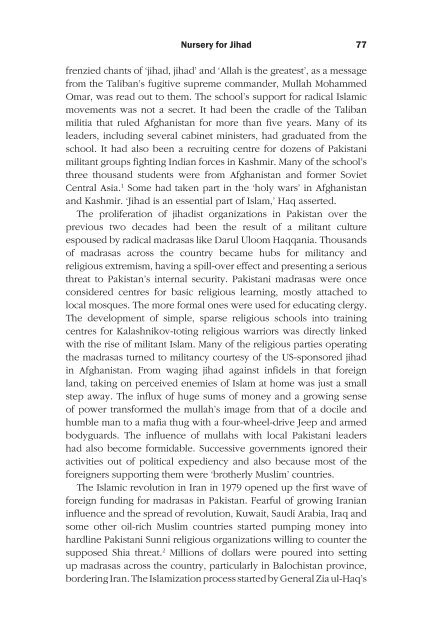Frontline Pakistan : The Struggle With Militant Islam - Arz-e-Pak
Frontline Pakistan : The Struggle With Militant Islam - Arz-e-Pak
Frontline Pakistan : The Struggle With Militant Islam - Arz-e-Pak
Create successful ePaper yourself
Turn your PDF publications into a flip-book with our unique Google optimized e-Paper software.
Nursery for Jihad<br />
frenzied chants of ‘jihad, jihad’ and ‘Allah is the greatest’, as a message<br />
from the Taliban’s fugitive supreme commander, Mullah Mohammed<br />
Omar, was read out to them. <strong>The</strong> school’s support for radical <strong>Islam</strong>ic<br />
movements was not a secret. It had been the cradle of the Taliban<br />
militia that ruled Afghanistan for more than five years. Many of its<br />
leaders, including several cabinet ministers, had graduated from the<br />
school. It had also been a recruiting centre for dozens of <strong><strong>Pak</strong>istan</strong>i<br />
militant groups fighting Indian forces in Kashmir. Many of the school’s<br />
three thousand students were from Afghanistan and former Soviet<br />
Central Asia. 1 Some had taken part in the ‘holy wars’ in Afghanistan<br />
and Kashmir. ‘Jihad is an essential part of <strong>Islam</strong>,’ Haq asserted.<br />
<strong>The</strong> proliferation of jihadist organizations in <strong><strong>Pak</strong>istan</strong> over the<br />
previous two decades had been the result of a militant culture<br />
espoused by radical madrasas like Darul Uloom Haqqania. Thousands<br />
of madrasas across the country became hubs for militancy and<br />
religious extremism, having a spill-over effect and presenting a serious<br />
threat to <strong><strong>Pak</strong>istan</strong>’s internal security. <strong><strong>Pak</strong>istan</strong>i madrasas were once<br />
considered centres for basic religious learning, mostly attached to<br />
local mosques. <strong>The</strong> more formal ones were used for educating clergy.<br />
<strong>The</strong> development of simple, sparse religious schools into training<br />
centres for Kalashnikov-toting religious warriors was directly linked<br />
with the rise of militant <strong>Islam</strong>. Many of the religious parties operating<br />
the madrasas turned to militancy courtesy of the US-sponsored jihad<br />
in Afghanistan. From waging jihad against infidels in that foreign<br />
land, taking on perceived enemies of <strong>Islam</strong> at home was just a small<br />
step away. <strong>The</strong> influx of huge sums of money and a growing sense<br />
of power transformed the mullah’s image from that of a docile and<br />
humble man to a mafia thug with a four-wheel-drive Jeep and armed<br />
bodyguards. <strong>The</strong> influence of mullahs with local <strong><strong>Pak</strong>istan</strong>i leaders<br />
had also become formidable. Successive governments ignored their<br />
activities out of political expediency and also because most of the<br />
foreigners supporting them were ‘brotherly Muslim’ countries.<br />
<strong>The</strong> <strong>Islam</strong>ic revolution in Iran in 1979 opened up the first wave of<br />
foreign funding for madrasas in <strong><strong>Pak</strong>istan</strong>. Fearful of growing Iranian<br />
influence and the spread of revolution, Kuwait, Saudi Arabia, Iraq and<br />
some other oil-rich Muslim countries started pumping money into<br />
hardline <strong><strong>Pak</strong>istan</strong>i Sunni religious organizations willing to counter the<br />
supposed Shia threat. 2 Millions of dollars were poured into setting<br />
up madrasas across the country, particularly in Balochistan province,<br />
bordering Iran. <strong>The</strong> <strong>Islam</strong>ization process started by General Zia ul-Haq’s













